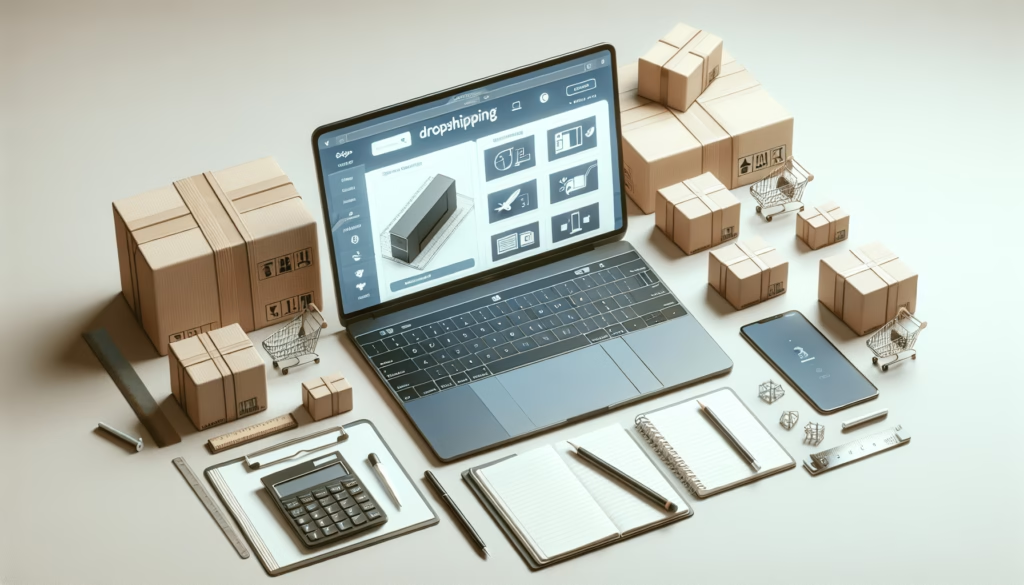
Have you ever thought about starting your own online business but felt overwhelmed by the process? Setting up a dropshipping store can be a fantastic way to enter the world of eCommerce, allowing you to sell products online without having to keep inventory yourself. Let’s walk through the necessary steps, one by one, to get you up and running.

Table of Contents
What is Dropshipping?
Before jumping into how to set up your store, it’s good to understand what dropshipping actually is. Dropshipping is a retail fulfillment method where a store doesn’t keep the products it sells in stock. Instead, when you sell a product, you purchase the item from a third party and have it shipped directly to the customer. You never see or handle the product. This model reduces the financial risk since you only pay for inventory after you’ve sold it.
Benefits of Dropshipping
You might be wondering why you should consider dropshipping over other business models. Here are some perks:
Low Startup Costs
Since you don’t need to purchase inventory upfront, the startup costs are much lower. You can create an online store without significant investment.
Wide Product Selection
You’re not limited to a specific set of items. You can choose various products from different suppliers to cater to various customer needs.
Flexibility and Convenience
As you can manage your business from anywhere with an internet connection, it allows for a flexible lifestyle, which is great if you’re looking for a remote work option.
No Need for a Physical Store
Having a physical storefront requires a lot of overhead—rent, utilities, staff, and more. With dropshipping, you can operate entirely online, saving substantial operational costs.
Choosing Your Niche
Now that you understand what dropshipping is and its benefits, it’s time to think about your niche.
Why is Choosing a Niche Important?
Selecting a niche is crucial because it helps you understand your target market and tailor your marketing strategies accordingly. Picking too broad of a market might dilute your efforts and make it hard to stand out.
How to Identify Your Niche
-
Evaluate Your Interests and Skills: What are you passionate about? Aligning your business with your interests can make the journey enjoyable.
-
Research Trends and Demand: Tools like Google Trends can help you identify what people are currently interested in. Consider checking platforms like TikTok or Pinterest for trending products.
-
Analyze Competitors: Look into existing stores in your potential niche. Understand their strengths and weaknesses, and see where you can stand out.
-
Evaluate Profit Margins: Not all products are created equal when it comes to profit margins. Ensure that the products you want to sell will yield a reasonable profit after expenses.
Finding Your Ideal Customer
Once you’ve settled on a niche, think about your ideal customer. What are their interests, pain points, and spending habits? Tailoring your offerings to meet their needs can enhance your sales potential.
Market Research
After finalizing your niche, it’s time to conduct in-depth market research. This helps you make informed decisions and reduces the risk of your business failing.
Tips for Effective Market Research
-
Use Surveys and Questionnaires: Engage your audience by sending them surveys to gather insights on their preferences.
-
Check Out Competitor Stores: Visit competitor websites to evaluate their product offerings, pricing strategies, and customer reviews.
-
Social Media Analysis: Platforms like Facebook and Instagram can provide insights into trending products and customer sentiments.
Analyzing the Data
Gather all the data you’ve collected and analyze it for patterns. Are there specific products getting a lot of attention? What are the common pain points mentioned by customers? This information will be helpful when you start to curate your own product offerings.
Choosing a Dropshipping Supplier
Once you have your niche and have conducted thorough market research, the next step is to find a reliable dropshipping supplier.
Qualities to Look For in a Supplier
- Reliability: Ensure the supplier has a good track record of shipping orders on time.
- Quality of Products: Order samples to assess the quality before committing to selling their products.
- Customer Service: Excellent customer service is essential for resolving issues promptly.
- Return Policy: Understand their return policy to know how it will affect your business.
Popular Dropshipping Suppliers
| Supplier | Specialties | Location |
|---|---|---|
| AliExpress | Wide range of products | China |
| Oberlo | Integrates with Shopify | Global |
| Printful | Custom print products | Global |
| Spocket | Fast shipping products | US/EU |
| SaleHoo | Directory of validated suppliers | Global |
Testing Your Suppliers
Don’t hesitate to test multiple suppliers. Place small test orders to evaluate how they handle issues like shipping times and product quality.
Setting Up Your Online Store
Now that you’ve chosen your niche and supplier, it’s time to create your online store.
Choosing the Right Platform
Selecting the right eCommerce platform is crucial. Here are some popular options:
- Shopify: Great for beginners, offers various features, and integrates easily with dropshipping apps.
- WooCommerce: A WordPress plugin that gives you full control over your store.
- BigCommerce: Offers robust features for growing businesses.
Picking a Domain Name
Your domain name is your store’s online identity. Choose something memorable, relevant to your niche, and easy to spell.
Designing Your Store
- Select a Theme: Choose a clean, responsive design that reflects your brand.
- Customize: Adjust colors, fonts, and layouts to create a unique look.
- Optimize for Mobile: Ensure your store is mobile-friendly, as many shoppers browse on their phones.
- Add Essential Pages: Include pages like “About Us,” “Contact,” “Privacy Policy,” and “Return Policy.”

Adding Products to Your Store
As you get your online store ready, one of the most thrilling aspects is adding products.
Curating Your Product List
Choose products that align with your niche. Make sure to include high-quality images and detailed descriptions.
- Product Titles: Use clear and descriptive titles.
- Descriptions: Highlight features, benefits, and how the product solves problems for your customers.
- Pricing: Set competitive prices while ensuring you have enough margin to cover expenses and profit.
Utilizing Product Variants
If your products come in different colors or sizes, ensure you set these as variants. This allows customers to choose what’s best for them without navigating away from the product page.
Setting Up Payment Gateways
To process payments seamlessly, you’ll need to set up payment gateways.
Popular Payment Solutions
| Payment Processor | Fees | Notes |
|---|---|---|
| PayPal | 2.9% + $0.30 per transaction | Widely used and trusted |
| Stripe | 2.9% + $0.30 per transaction | Great for online businesses |
| Square | 2.6% + $0.10 per transaction | Easy integration for eCommerce |
Tips for Payment Processing
- Choose Multiple Options: Offering various payment options can increase conversions.
- Ensure Security: Opt for processors that offer fraud protection.
Creating a Marketing Strategy
Your dropshipping store needs customers, and that’s where a robust marketing strategy comes in.
Building a Brand
Your brand is more than just a logo. It includes your store’s values, voice, and customer service. Strong branding can help you stand out in a crowded marketplace.
Utilizing Social Media
Platforms like Instagram, Facebook, and Pinterest are effective for promoting your products. Create engaging content showcasing your products and connect with your audience.
Email Marketing
Building an email list is crucial for retaining customers. Use tools like Mailchimp or Constant Contact to create and send newsletters, promotions, and product announcements.
Search Engine Optimization (SEO)
Optimize your website for search engines to attract organic traffic. Here are a few key strategies:
-
Keyword Research: Identify relevant keywords and incorporate them into your product titles, descriptions, and blog content.
-
High-Quality Content: Consider starting a blog to share valuable content related to your niche. This can attract traffic and establish your store as an authority.
-
Meta Descriptions: Write compelling meta descriptions for your pages, as they can impact click-through rates from search engines.
Paid Advertising
Consider investing in paid advertising to boost your visibility. Platforms like Facebook Ads and Google Ads can be effective for reaching new customers.
Managing Your Dropshipping Business
Once your store is live and you start attracting customers, managing your business effectively becomes key.
Order Fulfillment
As orders start flowing in, you’ll need to manage the order fulfillment process efficiently.
-
Setting up Automations: Many eCommerce platforms allow you to automate aspects of order processing, which can save you time.
-
Monitoring Supplier Performance: Stay in contact with your suppliers to ensure smooth shipping and product quality.
Customer Service
Providing excellent customer service can greatly influence your store’s reputation.
-
Be Responsive: Promptly answer customer inquiries via email or chat.
-
Handle Returns Well: Clearly communicate your return policy and make the returns process as seamless as possible.
Tracking Analytics
Utilize analytics tools like Google Analytics to monitor your website traffic and sales performance. Understanding customer behavior can help you make informed decisions about your marketing strategies.
Scaling Your Business
After successfully managing your dropshipping store, it may be time to scale your business.
Expanding Product Lines
Consider adding more products or categories based on customer feedback and market demand.
Investing in Marketing
Once you establish a steady revenue stream, consider investing more in marketing to attract new customers.
Automating Operations
As your store grows, look for tools and software to automate repetitive tasks. This can free up your time to focus on strategy and growth.
Legal Considerations
Starting a dropshipping store comes with legal responsibilities.
Business Structure
Decide what type of business structure you will operate under, whether it’s a sole proprietorship, LLC, or corporation.
Check Licensing Requirements
Depending on where you live, you may need specific licenses or permits. Make sure to check your local regulations.
SEO and Content Legal Concerns
Be aware of copyright and trademark issues when creating your website content and marketing materials.
Conclusion
You’re now equipped with the knowledge you need to start your own dropshipping store. Although it may seem daunting at first, breaking it down into steps makes it manageable. Stay committed, adapt to changes, and continuously strive for improvement. Success in dropshipping doesn’t happen overnight, but with persistence and the right strategies, you can achieve your goals.
Your journey begins now—embrace it with enthusiasm and enjoy the adventure of entrepreneurship!







